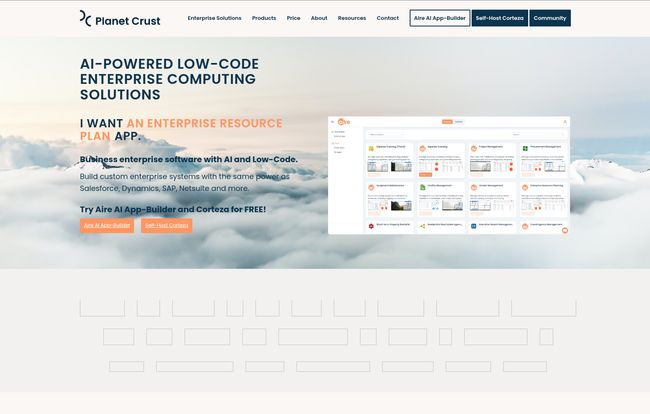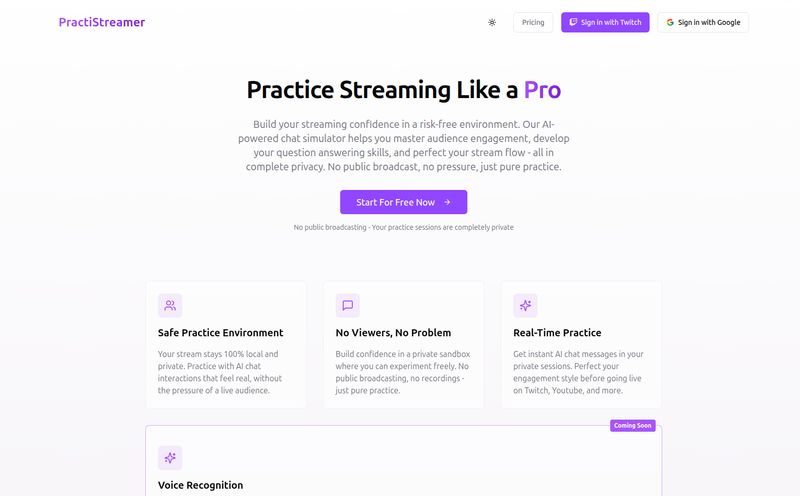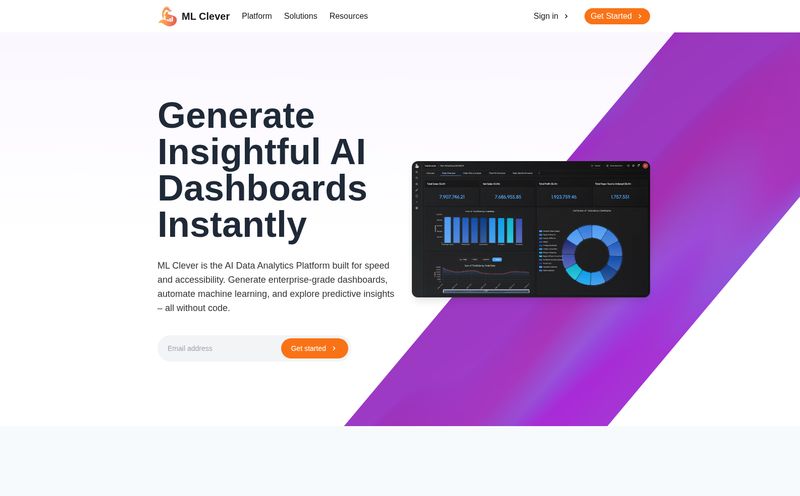Staring at a blank screen, knowing you need to build a simple internal tool—a customer tracker, an inventory manager, a project dashboard. The idea is crystal clear in your head. But the thought of actually architecting the database, defining all the fields, linking the tables, and then building the user forms… it’s enough to make you put the kettle on for the fourth time. It's the grunt work of development, the necessary but tedious foundation laying.
For years, the low-code and no-code movements have promised to speed this up. And they have, to a degree. But what if you could skip even that? What if you could just… describe the app you want, and have the entire data structure and initial UI just... appear? It’s been the holy grail for a while now, and with the AI boom, it’s starting to feel less like science fiction. Which brings me to a tool that landed on my radar recently: Aire.
It claims to be an AI-powered data model builder for a platform I'm a big fan of, the open-source low-code platform Corteza. So naturally, I had to see if it lived up to the hype.
So, What Exactly is This Aire Thing?
In the simplest terms, Aire is an AI assistant that lives inside the Corteza ecosystem. Think of it less as a standalone app builder and more like a brilliant, hyper-fast intern for your development team. It’s a product from Planet Crust, the same people who are the primary stewards of the Corteza project, so the integration is, as you'd expect, pretty tight.
You don't use Aire to build an entire, complex, workflow-heavy application from start to finish. Instead, you give it a single prompt. A simple sentence. Aire’s job is to take that sentence and do the most boring, time-consuming part of app creation: it builds the data model. It figures out the modules you need, the fields within those modules (text, numbers, dates, etc.), and sets up the basic relationships. And it doesn't just stop there; it also generates a starting set of pages, charts and dashboards to get you going. It's like an architect who draws up perfect blueprints in seconds. You still need the construction crew (Corteza) to build the house and decorate it, but the foundation is poured and framed instantly.
Who is This For? (And Who It Isn't For)
I think Planet Crust has been pretty smart about who they're targeting here. It's not just for hardcore developers.
- Citizen Developers: This is the most obvious group. The person in marketing or HR who's handy with tech but doesn't know SQL from a sequel. For them, Aire is a massive leap, allowing them to create the backbone of a real, scalable app without needing to call IT.
- Technical Project Managers: We've all been in meetings where a PM has to translate business needs into technical specs. With Aire, they can build a functional prototype during the meeting. The power to say "You mean something like this?" and actually show a working model is huge.
- Application Owners & Seasoned Devs: Even for us pros, this is a speed boost. It handles the scaffolding. It lets me focus on the interesting parts—the complex workflows, the custom integrations, the tricky business logic—instead of spending an hour creating 20 fields for a contact form.
Now, let's be real. It’s not for everyone, at least not yet. If you need to build an app that isn't based on structured records (like a video game or a real-time collaboration tool), this isn't your tool. And, as we'll get into, its real power is unlocked when you're ready to get your hands a little dirty in Corteza itself.

Visit Aire
How Aire Actually Works: From Prompt to App
The process is refreshingly straightforward. It’s not some convoluted, multi-step wizard. It’s a conversation.
You start with a prompt. Something like:
I need a system to manage event registrations, including attendee information, ticket types, and payment status.
You feed this to Aire. It goes away for a few moments (literally, like, less time than it takes to explain it) and comes back with a proposed data model. It might suggest a module for 'Events,' another for 'Attendees,' and a third for 'Tickets.' It'll pre-populate them with logical fields: 'Event Name' (text), 'Event Date' (date), 'Attendee Name' (text), 'Email' (email), 'Ticket Price' (currency), 'Paid' (boolean checkbox).
This is where the "human-in-the-loop" part comes in, which I love. It’s not a black box. You can look at its proposal and say, "Hmm, nice, but I also need a field for 'Dietary Restrictions' on the Attendee module." You can add, edit, or delete anything before committing. Once you give it the thumbs-up, it builds the model, generates the user interface pages and a dashboard with a few useful charts, and deploys it directly to a Corteza instance. From there, it's a living, breathing web app that you can start using or, more likely, start customizing further within the standard Corteza low-code builder.
The Good, The Bad, and The "Coming Soon"
No tool is perfect, right? After playing around with it, here's my honest breakdown.
The Wins: Why I'm Genuinely Excited
The speed is the headline feature, and it’s not an exaggeration. Building a solid data model in minutes instead of hours is a massive productivity gain. But for me, the real win is the accessibility. It lowers the barrier to entry for creating genuinely robust, enterprise-grade applications. Because Aire builds on Corteza, you’re not getting a toy. You’re getting the foundation for an app that can have proper permissions, be integrated with other systems via API, and be customized to your heart's content. It democratizes the start of the process, and that's a big deal. The fact that it integrates with an open-source platform means you're not trapped in a proprietary walled garden—a fear I hear from clients all the time.
The Reality Check: Where It Hits Its Limits
Okay, deep breath. Aire is cool, but it's not magic. The biggest limitation right now, and they're up front about this, is that it doesn't build workflows. It will set up the data structure for your event registration app, but it won't automatically build the workflow that sends a confirmation email when someone's payment status changes to 'Paid.' That's a task you'd handle in the Corteza workflow builder. They say this is planned for a future release, and I'll be watching for that eagerly.
It also only builds data models for records-based web apps. Again, this is most internal tools—CRMs, HR systems, project trackers—but it's a limitation to be aware of. Lastly, while you don't need Corteza knowledge to use Aire, you absolutely need it to take your app to the next level. Aire gives you the starting blocks, but the rest of the race is run in Corteza. This isn't really a con, just a reality of the setup.
Let's Talk Money: The Aire Pricing Breakdown
This is always the big question. Planet Crust has a tiered approach which I think is pretty sensible. I'm pulling this straight from their pricing page, so it's current as of this writing.
| Plan | Price (Monthly) | Key Features |
|---|---|---|
| Aire Free | $0 | 3 apps, app preview, deploy to a shared Corteza instance. Perfect for testing. |
| Aire + | $197 | 10 apps per month, adds access to advanced low-code features and the admin console. |
| Higher Tiers | $597+ | These tiers are for serious enterprise use. They add options for self-hosting, dedicated support, training, and even exporting your source code. |
My take? The free tier is genuinely useful. It's not one of those crippled demos; you can actually build and deploy a few simple apps to see if you like the feel of it. The Aire + tier at $197/month feels like the sweet spot for small businesses or active teams who want to move fast. When you factor in the developer hours saved, that cost can be justified pretty quickly. The higher tiers are clearly aimed at companies betting big on the Corteza platform, and for them, the control and support are non-negotiable.
Is Aire a Game-Changer for Low-Code Development?
I've seen a lot of tools come and go. I'm usually skeptical of anything that promises to eliminate work. But Aire feels different. It's not trying to be a one-click magic button that builds a flawless, finished app. It’s a targeted tool that solves a very specific, very annoying problem: getting started. It's an accelerator, not an autopilot.
It reminds me of AI code assistants like GitHub Copilot, but for the low-code world. It doesn't replace the developer (or the citizen developer), it just makes them faster and more efficient. By automating the data modeling, it frees up human brainpower to focus on the things that actually require creativity and critical thinking. And that, in my book, is a huge win.
Conclusion: Should You Give Aire a Spin?
So, does Aire live up to the hype? For what it claims to do, I'd say a resounding yes. It is an incredibly fast AI-powered data model builder for the Corteza low-code platform. It will not build your entire business on its own, but it will give you a powerful, scalable, and customizable head start.
If you're already using Corteza or you're in the market for an open-source, scalable low-code platform, trying Aire is a complete no-brainer. The free plan is right there, and you can get a feel for the workflow in about ten minutes. It’s one of those rare tools that might just change how you approach the start of every new project. And anythng that saves me from another pot of procrastination-coffee is a winner in my book.
Frequently Asked Questions about Aire
- What is Aire in simple terms?
- Aire is an AI tool that builds the initial data structure and user interface for a web app based on a simple text description. It works specifically with the Corteza open-source low-code platform.
- Do I need to know how to code to use Aire?
- No. To generate the initial app with Aire, you don't need any coding or even low-code experience. However, to significantly customize or enhance the app afterwards, you'll need to learn the Corteza low-code interface.
- Is Aire just for Corteza?
- Yes, currently Aire is designed to work exclusively with the Corteza platform. It builds and deploys applications directly into a Corteza environment.
- Can I export my app and host it myself?
- Yes, you can. Self-hosting and source code export are features available on the higher-tier subscription plans, designed for businesses that require full control over their data and infrastructure.
- What kinds of apps can I build with Aire?
- Aire is best for building records-based business applications. Think of things like CRMs, project management tools, inventory systems, HR directories, support ticket trackers, and similar internal tools.
- Is Aire really free to try?
- Absolutely. There is an 'Aire Free' plan that lets you build and deploy up to 3 applications on a shared Corteza instance. It's a great way to test the platform's capabilities without any financial commitment.



